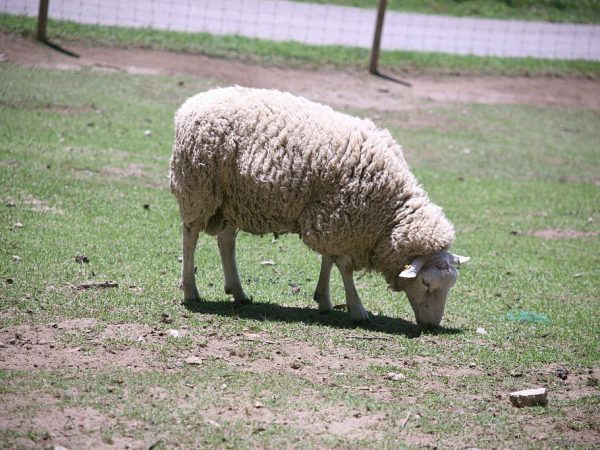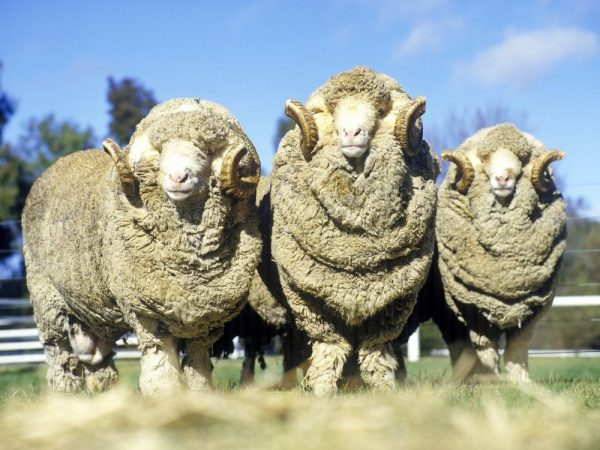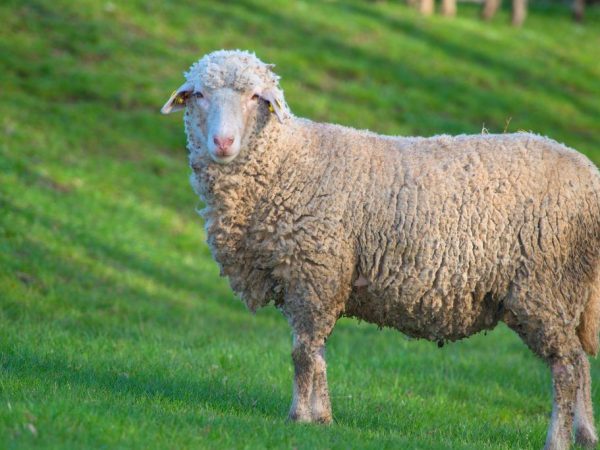Description of the breed of fine wool sheep
The fine wool sheep breed is popular in many countries. Merino was bred in Asia and did not leave its territory for a long time. Over time, the ram of this breed was exported to Spain. This country has been a monopolist in the production of wool, leather and meat for many years.

Characteristics of Sheep of Fine-wool breed
But the Fine Fleece Sheep was able to leave the territory of Spain. It was after this that the country ceased to be a monopolist in the production of sheep products of this breed. In the modern world, this type is known on all continents.
Description of the breed's wool
Sheep wool is of high quality and price. It is often used to create a wide variety of products. The coat is soft to the touch. Its main advantage is that it retains heat well. Moisture is not terrible for this material, moreover, it has good hydroscopic characteristics.
In order to cut the fur, it is necessary to use a tool such as a solid fleece. The skin of the breed secretes a special substance that protects the rune from the influence of frost. Fine-wooled breeds of sheep have a wool consisting of hairs, the length of which reaches 25 micrometers. This suggests that its quality corresponds to 80%. The length of one hair is 9 cm, the grading is soft and light.
Today, thanks to selection, 3 main types of the breed have been bred:
- woolen;
- wool and meat;
- meat.
The productivity of the sheep is high, which is why it is the fine-wool sheep breeding that is so popular. From one such pet, you can get several times more products than from a coarse-haired individual.
The fine wool breed differs in size and productivity. In the modern world, each country has developed its own type of this breed, which is adapted to living in it. The characteristics of each species are similar to each other, but there are some differences.
Wool type sheep
The fine-wooled sheep of the wool type is popular in Russia, because it is best adapted to its climate. Sheep are often found in the north of the country.
Popular types:
- Grozny;
- Salsky;
- Azerbaijani;
- Stavropol.
The wool type of such a sheep has its own characteristics. The main thing is that animals are lightweight and all skin is covered with folds. Their subcutaneous fat is almost undeveloped. The skin is covered with folds around the neck, shoulder blades and thighs. This allows a large amount of wool to be taken from view.

Wool type sheep
The soft coat is the main feature of this subspecies. So, from a lamb you can take up to 5 to 8 kg of product, and from a ram - up to 18 kg. The female can gain weight up to 60 kg, and the male - up to 100 kg. There are many developed breeds of this type in the modern world, and those indicated above are a small part of them.
Lamb wool-meat type
The fine-wooled wool-meat breed has a greater weight and size than the wool breed. There are no pronounced folds on the skin, but the body structure of this type is more powerful.
To date, 8 breeds are known:
- Askanian;
- Caucasian;
- Transbaikal;
- Kyrgyz;
- South Ural;
- North Caucasian.
The fine-wool sheep of the wool-meat type has a large body with well-developed muscles. Also, this species is distinguished by a good layer of fat and high-quality meat. Sheep gain weight up to 110 kg, and sheep can weigh up to 65 kg maximum.

Fine wool sheep of wool-meat type
The male can give 15 kg of wool in one year, and the female - 6 kg. The length of one hair in this type is 9 cm. Its main advantage is high quality meat. The wool-meat type can most often be found in different regions of Ukraine, because these animals are adapted to a temperate climate.
Meat-wool type of breed
Fine wool sheep of this type are valued for the quality of their wool. Another feature of such an animal is productivity: it is several times higher than that of previous species. There are breeds that are similar to semi-fine wool breeds. A semi-fine-fleece animal is not so whimsical. Most of them live in Russia.
In the modern world, there are 6 bred meat-and-wool breeds:
- Precos;
- Kazakh traditional lamb;
- Mountain Dagestan;
- Vyatskaya;
- Georgian fat-tailed sheep;
- Kazakh.
They have thin skin that is not wrinkled. Thanks to this, you can get high-quality meat and wool from them. The thin skin was given to them by a semi-fine-fleece animal. Another advantage of this species is that the pets grow quickly. So males reach a weight of 100 kg, and females can weigh 60 kg.

Meat-type fine-fleece sheep
On average, animals produce about 6 kg of wool per year. In rams, this indicator is several units higher. Pets are easily rehabilitated in a new place and can tolerate any temperature regime. If you feed meat and wool sheep correctly, you can get several times more meat and wool.
Features of caring for a fine-fleece sheep
Sheep breeding is a rather difficult occupation that not everyone can master. But if you decide to take up this direction, then it is better to start with fine-wool sheep, because everyone can understand the rules of care and maintenance of the breed. They should live in special kennels, which are equipped with a small corral. Also, there should be a sufficient number of feeders and drinkers in the kennels.
The shed must be regularly cleaned and treated from the fungus, if it appears. It is desirable that there is light in the room and there is no draft. The floor is made from planks, which are covered with straw on top. This is a prerequisite for their normal development. If you do not follow this rule, the rams will start to get sick.
It is necessary to inspect the sheath regularly. It should not have any holes through which rain or cold wind can enter. The air temperature in the room in winter should not be lower than 8 degrees. It is necessary to start grazing the breed in spring, when the grass has grown sufficiently in height. The best time for this is when the dew melts, because pets feel very bad with wet hair.
In summer, animals can graze early in the morning. Concentrated feed must be included in the diet of fine-wool sheep. In winter and autumn, fruits and vegetables should be included in the menu. They will saturate the animal's body with all the necessary vitamins. In the cold season, the composition of feed must include all the vitamins and minerals necessary for normal development.
Fine wool breeds that have long coats need regular bathing. This is necessary so that parasites do not start and the wool does not lose its basic qualities. It is enough to bathe your pets several times a year. The first time this should be done in the spring, then in the summer and autumn. It is also imperative to bathe the sheep a few weeks before shearing.
Features of cutting fine-wool breeds
The first time a lamb can be sheared in the spring.You must first bathe the animal 2 weeks before: it is during this period that the wool is of the highest quality. If you wish, you can choose any other time of the year. It all depends on the age of the pet.
It is worth preparing for a haircut in advance. At this point, the animal must have a fairly large weight. To cut your pet, you need to prepare special tools in advance.

The process of shearing fine wool breeds
The process itself does not take much time, especially since the sheep do not resist during shearing. The pet needs to be laid on a wooden surface and you can safely start the process. After clipping, the wool needs special treatment. To do this, you need to prepare a soap and soda solution. In it, you need to wash the products 3 times, then just dry them.
Breeding the breed
The main characteristic of the fine-wool breed makes it clear to the breeder that puberty in sheep is earlier, therefore, animals are ready for mating already at 6 months. Despite this, to obtain offspring, pets are selected that are already one year old. The female and male are taken in the fall. This is done so that childbirth occurs in winter or spring.
The ram with the lamb is closed in a separate room for several days. Feeding and caring for them during this period is the same as before. The female bears offspring on average 21 weeks.
Care for a pregnant pet remains the same, but more vitamins and minerals should be added to the menu. This is necessary so that the mother does not lose her weight and coat quality after giving birth. Sheep give birth very quickly, within half an hour. The birth itself most often takes place without human intervention.
Immediately after giving birth, the lamb rises to its feet. As soon as this has happened, the baby can be placed with the mother for feeding. The main food of a lamb up to 3 months is female milk. From one month of age, you can enter feeding.
If the mother does not have enough milk to feed all the offspring, then the babies are placed with another female. From 3 months old babies are happy to eat adult food. There are times when, from the age of one month, they begin to introduce adult food. This most often happens when the mother refuses to feed the babies or she does not have enough milk. Then the diet of the lambs becomes similar to that of an adult, but the only condition is that all the feed is crushed.
Conclusion
The fauna is interesting and mysterious, there are often interesting breeds of sheep. One of these breeds is the fine-fleece ram. These types give a large number of the most diverse products. That is why in the modern world they are bred in many regions.
This species has many advantages, the main one is that they rarely get sick. You can also get milk, wool, meat and fat from them. The skin of this pet is also used in different directions, so there is simply no reason not to have such a breed.


